#victorian romanesque homes
Explore tagged Tumblr posts
Text

Absolutely incredible 1902 Victorian Romanesque home in Alpena, MI is being sold furnished. 5bds, 4ba, 7,443 sq ft, $2.79m.

This home is impeccable.



Everything from the furniture, to the art, to the rugs, lamps and tchotchkes all come with it.

What a gorgeous desk. I guess you get the plants, too.


Love the kitchen. The cabinets are so pretty and it's a cook's kitchen.


The owners commissioned an artist to paint the murals on the dining room wall in oil paint on canvas. Aren't they gorgeous? Unique fireplace, too.

This is a large powder room. Love the tile.

Each bedroom is beautifully furnished.

Lovely bright vintage bath.


This bedroom features a seating area in the tower.


The bathroom sink was made from an amazing antique piece.

The beds in this room are fantastic. I wonder how much of the price is going toward the antique furniture.

After painstakingly decorating this home, I can't believe that they're selling it complete.

Look at the cute little sink in this room.

The finished attic looks like a pub.

There's an extra bedroom up here with two more beautiful antique beds.

Wonderful big porch.

The home is on a .42 acre lot.

Located in a lovely neighborhood just across the road from Thunder Bay.

Tennis courts nearby.




https://www.zillow.com/homedetails/303-S-State-Ave-Alpena-MI-49707/226496220_zpid/
#victorian homes#victorian romanesque homes#old house dreams#furnished homes#houses#house tours#home tour
501 notes
·
View notes
Text

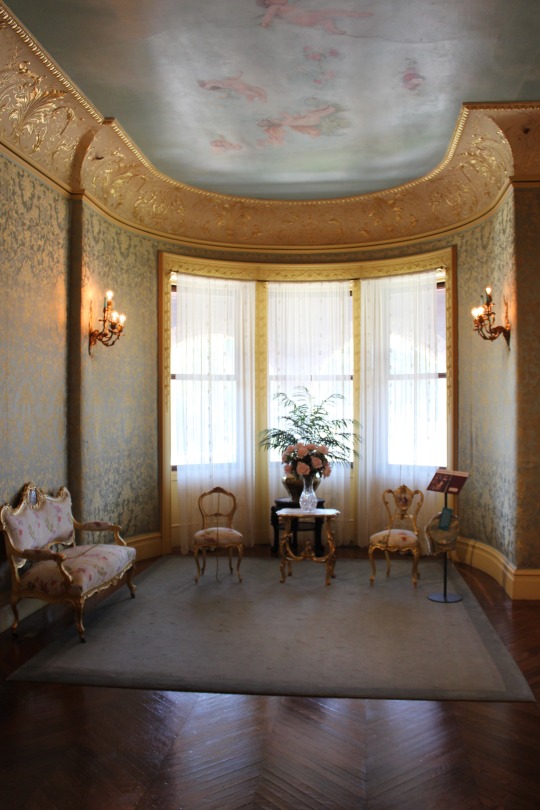
The Moody Mansion, Galveston, TX
📸: @the-darling-house
#home decor#interior design#interiors#maximalism#romanesque#maximalist decor#antique#antique aesthetic#photography#aesthetic#room inspo#living room#victorian era#victorian mansion#late 1800s#galveston#painted ceiling#pic by me
21 notes
·
View notes
Note
hey!! i really love your posts and trust me when i say this but you're practically doing a work of charity by making all these synonym lists. 😩🫶
i was wondering if you could compile monument vocabulary. vocabulary to describe the intricate and exquisite designs inside historical buildings. tysm!
Some Historical Architecture & Interior Design Vocabulary
Acanthus Leaf - A leaf decoration often used on furniture, particularly on brackets and legs.
Acroterium - Originally an ornament on the roof corners of Greek temples. In classical furniture, similar ornaments applied to the top corners of secretaries, bookcases, highboys and other furniture.
Amorini - Cupid ornaments found on Italian Renaissance furniture.
Anthemion - A honeysuckle design from classical Greek decorative motifs. Term refers to any conventional flower or leaf design.
Antique - Could be anything ranging from a piece of furniture to art. The U.S. government considers any item over 100 years old to be an antique, whereas most collectors use 50 years as a benchmark.
Apothecary Chest - A low chest with small drawers that was originally used to store herbs for cooking and medicinal purposes.
Arabesque - Decorative scroll work or other intricate ornamentation consisting of foliage, vases, leaves and fruits, or fantastic human and animal figures.
Baroque - A highly ornate decorative style that originated in Italy in the 1600's. The style is characterized by irregular curves, twisted columns, elaborate scrolls and oversize moldings. The Italian equivalent of French "rococo".
Bibliotheque-Basse - A low cupboard with shelves for books. Doors are often of glass and sometimes fitted with grilles.
Bullate - Having the surface covered with irregular and slight elevations, giving a blistered appearance.
Cabriole leg - An ornamented furniture leg with a double curve structure.
Chevron - A 'zigzag' pattern characteristic of Romanesque decoration that is often carved around pillars, arches and doorways.
Chinoiserie - A European style of design that is meant to mimic elements of East Asian art.
Console table - A freestanding table, often found in the entryway of homes, that typically serves as a space for decorative elements.
Enfilade - A series of rooms that are connected via doorways that align with one another (commonplace in grand castles, like the Palace of Versailles, or even museums).
Etagere - A freestanding or hanging set of open shelves, designed to display trinkets or other decorative objects.
Gilding - A coating with a thin layer of gold or gold-like substance.
Klismos - Ancient Greek style of chair with saber shaped legs splayed at the front and back. The back legs continue up to support a shoulder-height curved back.
Laurelling - A decorative feature using the laurel leaf motif as its basis.
Lozenge - A diamond shaped decorative panel. Term comes from the Middle English word for stone.
Niche - A recess in a wall for displaying a sculpture or other accessory.
Ormulu - A metal resembling gold. Used as mounts and decorative effects on furniture.
Ovolo - A continuous ornament in the form of an egg which generally decorates the molding called the "quarter-round". Eggs are often separated from each other by pointed darts.
Passementerie - Fancy decorative trimmings such as tassels, tiebacks and ribbon.
Régence Style - This furniture style spanned from about 1715 to 1723, when France was ruled by a regent. This style of furniture design was a transition from massive straight lines to graceful curves.
Sconces - A type of light fixture that is fastened to a wall for support.
Swan-Neck Handle - A curved handle popular in the 1700's.
Trompe l’oeil - A technique used to trick the eye into thinking that something flat, like a wall, is actually three-dimensional. This is often achieved through photorealistic painting.
Victorian - An architectural style defined by highly ornamented design and grand, sweeping facades.
Wainscoting - A type of interior wall paneling that covers the lower portion of a wall.
"Traditional" Interior Design
When talking about traditional interior design, most are referencing a design style that originated in the 18th and 19th century throughout Europe. However, it’s worth noting that other cultures have their own versions of a traditional style that may not look the same as this more Western version.
Traditional Design Elements. Though not exhaustive, a traditional interior will often make use of the following elements:
Emphasis on symmetry and order
Traditional architectural details such wainscoting and crown molding
Classic decor elements such as chandeliers and bookcases
Neutral color schemes with pops of bold colors, often in jewel tones
Upholstery and textiles tend to be subtler (cotton, velvet, or wool, for example)
Furniture pieces with traditional silhouettes, though they’re often updated with modern elements or finishes
Layered window treatments and draperies; curtain valances aren’t used often
Classic patterns such as plaids, damask, or florals
Flooring tends to make use of darker wood
Sources: 1 2 3 4 ⚜ More: Notes & References ⚜ Word Lists
Previous posts that include some related words you might find useful:
Some Architecture Vocabulary
Some European Renaissance Art Vocabulary
Some Medieval Art & Architecture Vocabulary: Part 1
Some Medieval Art & Architecture Vocabulary: Part 2
Some Roman Art Vocabulary
Thanks so much for your kind words, you're really sweet! I tried to include a wide range of terminology since you didn't specify which time period you were looking for. Do go through the sources if I wasn't able to include here what you need in your writing. Hope this helps <3
#terminology#architecture#interior design#writing reference#writeblr#dark academia#spilled ink#literature#writers on tumblr#writing prompt#writing inspiration#history#writing ideas#creative writing#writing resources
76 notes
·
View notes
Text
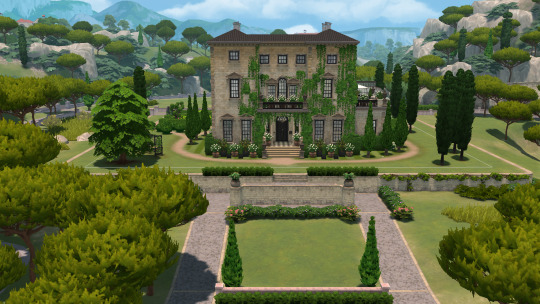
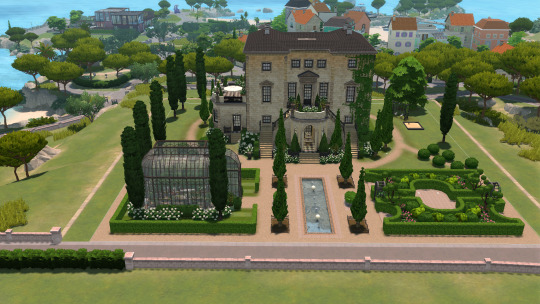
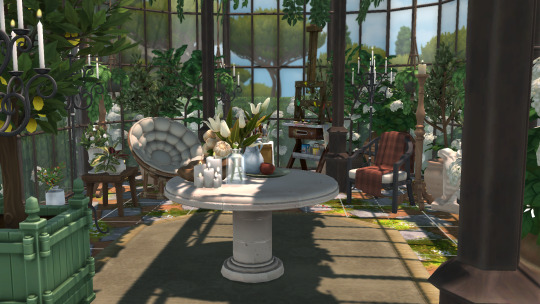
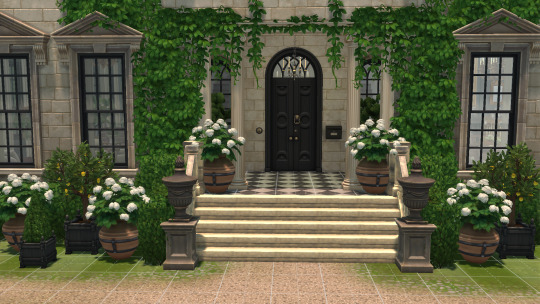
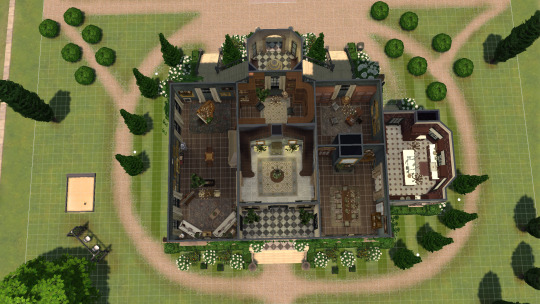
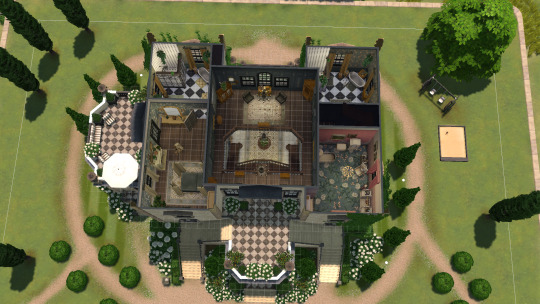
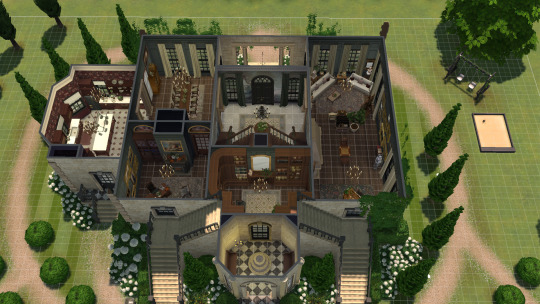
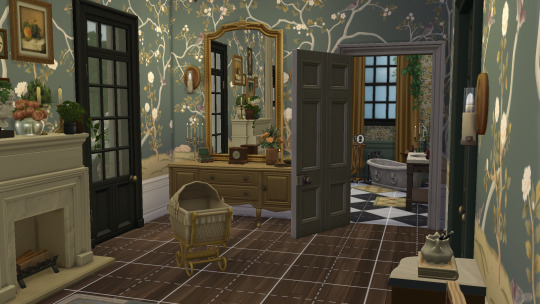
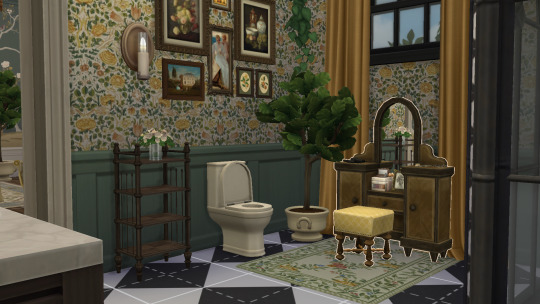
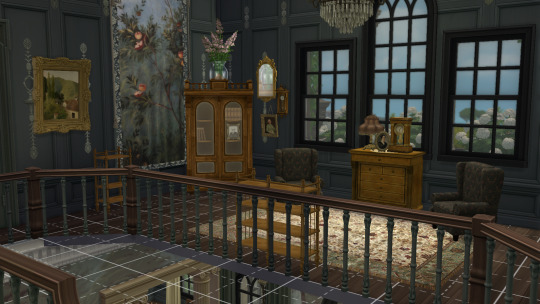
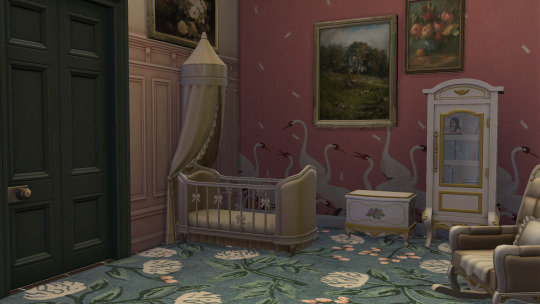
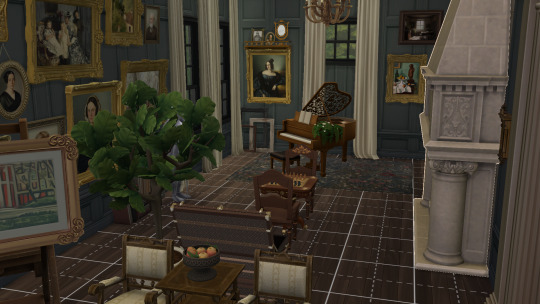
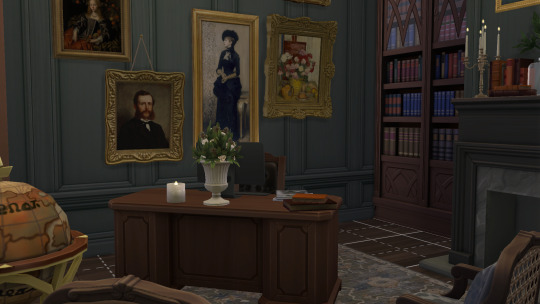
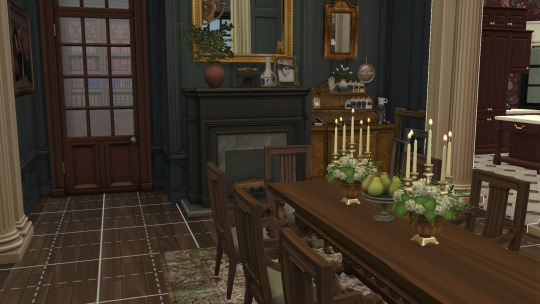
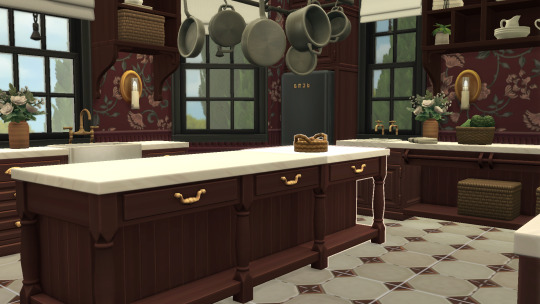
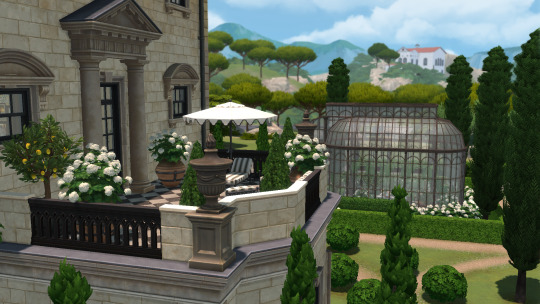
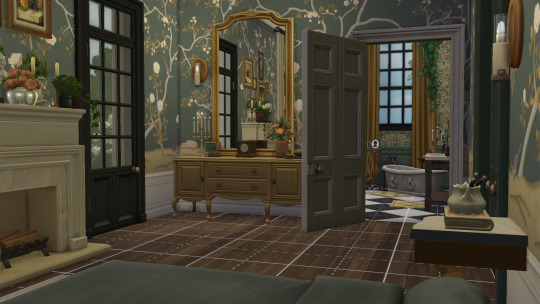
Thebe Estate, Tartosa
I'm a huge Felixandre fan, if you haven't seen his phenomenal work, you are missing out. I think most everyone who builds in Sims 4 knows his fantastic works and his architectural is by far top tier. With the release of his Estate set, I thought the Thebe Estate in Tartosa could use a little makeover.
My inspo was to keep the overall layout of the build. I love that it already has the feel of an established estate, I just wanted to give it a bit more, "Old Money' vibe. I set out to not only find items that kept a modern furnishing, but my IRL love of thrifting and antiquing had me wanting to find pieces that felt like they might be heirloom, or restored finds.
Redecorating is probably one of my favorite parts of the gameplay and has been since I first discovered the Sims 1 in the early 2000s. I hope you guys love it.
Details are listed below for creators and items used. Anything not specifically stated by a creator is from a Maxis pack.
Thebe Estate, Tartosa
$699,459
Bed - 4 Bath - 4
Exterior items - Felixandre: Estate set
Harrie: Coastal Arbour and sandbox with pail and spade
Greenhouse - Lili's Palace: Budapest set
Pierisim: Winter Garden
House of Harlix: Kichen hanging greenery
Kirsicca: Stone step terrain for flooring
Antiques in home - Lili's Palace: Intarsia set, Heirloom
KHD: Elodie, Avonlea, Countess
PlatinumLuxeSims: LV trunk (open and closed)
Bathrooms - Felixandre: Florence set, Lili's Palace: Budapest set for shower door and wall
Furniture - Felixandre: Chateau Set, Fayun Sofas, Florence Dining
Rugs - Sooky: English Countryside, Loloi Area Giada Collection
Simplistic: Rifle Paper Co
Walls - Sooky: Victorian Wall, William Morris Wallpapers with Panelling
Felixandre: Colonial Crane, Estate Set Panelling Wall, Georgian Panorama, Chateau Molding, Chateau Chinoiserie Wall
Harrie: The Apartment Copenhagen - Swedish Panelling
Flooring - Sooky: checkered marble floors, Victorian floor tiles
Pierisim: MCM wood floor
Felixandre: Chateau marble floors
Fireplaces - Felixandre: Paris Fireplace, Gothic Revival Fireplace 2
Harrie: Coastal Fireplace,
Lili's Palace: Intarisa: Renaissance Revival Ceramic Stove
Florals - House of Harlix: Orjanic
Felixandre: Chateau, Florence,
Pierisim: Coldbrew, Woodland Ranch, Precious Promises, Winter Garden, Domaine du Clos, David's Apartment, Oak House
Sofa Pillows - Peacemaker_ic ( find also under Simsational Designs)
Television - CharlyPancakes Art Telly
Desktop - Pierisim The Office Mini kit
Artwork - Thrifted Art, Florence Set, Chateau Set, KHD Romanesque Small Tapestry, Lili's Palace Intarisa (all), Sooky framed art and vintage art, and Dark Academia
Misc - Maison Meuliere doorbell, KHD Antique Chandelier, MF buncha books, bbygyall123 magazines, vanity clutter, pumpkinspice candle, tuds shkr ceramic bowl
24 notes
·
View notes
Text
41 BUILD STYLES
Hey simmers, today I share with you my list of build styles I use. So most of these styles I have never built before. I put this list in a wheel spinner, you can copy and paste it in, then let the wheel spin and see what build style it lands on.
I usually search the build style on pinterest and then pick a design from there for my Sims 4 build. You can decide after the wheel has selected a style if it should be removed from the list or remain for a possible second build. Also you can save the wheel spin list in the top right corner of the website there is options then you do not have to keep putting the list in.
The List:
A-Frame
Antebellum
Art Deco
Asian
Barn dominium
Bungalow
Brutalist
Cabin
Cape Cod
Colonial
Contemporary
Cottage
Country
Craftsman
Dutch Colonial
Eastlake
Farmhouse
Federal Architecture
French Country
French Provincial
Georgian
Greek Revival
Gothic Revival
Italianate
Log Home
Mediterranean
Mid Century modern
Modern
Neoclassical Architecture
Pueblo
Prairie
Queen Anne
Ranch
Romanesque Revival
Rowhouse
Saltbox
Shingle
Spanish
Townhouse
Tudor
Victorian
I would love to see your builds!! Let me know and share me your socials so I can follow! My YouTube channel <3
Have a lovely day further!
#my sims#simblr#sims 4#the sims#the sims 4#sims 4 build#sims 4 build ideas#build ideas#build styles#sims 4 building tips
16 notes
·
View notes
Text
Victorian house

Typical Victorian terraced houses in England, built in brick with slate roofs, stone details and modest decoration.
In Great Britain and former British colonies, a Victorian house generally means any house built during the reign of Queen Victoria. During the Industrial Revolution, successive housing booms resulted in the building of many millions of Victorian houses which are now a defining feature of most British towns and citie.
In the United Kingdom, Victorian houses follow a wide range of architectural styles. Starting from the early classicism inherited from Regency architecture, the Italianate style gained influence in the 1840s and 1850s, and the Gothic Revival style became prevalent by the 1880s. Later in the Victorian era, the Queen Anne style and the Arts and Crafts movement increased in influence, resulting in the transition to styles typically seen in Edwardian houses. Victorian houses are also found in many former British colonies where the style might be adapted to local building materials or customs, for example in Sydney, Australia and Melaka, Malaysia.
The Victorian Society is a membership charity which campaigns for Victorian architecture.
In the United States, Victorian house styles include Second Empire, Queen Anne, Stick (and Eastlake Stick), Shingle, Richardsonian Romanesque, and others
Victorian house - Wikipedia
What are the different styles of Victorian houses?
The most common Victorian style is Folk Victorian. The classic Victorian styles (Gothic Revival, Italianate, Second Empire, Stick Style, Romanesque Revival, and Shingle Style) were created by professional architects, and were built mostly by the well-to-do.
Victorian America had fashions in house design, exactly as we have fashions in clothing or hair style — except that well-to-do Victorians took the design of their homes far more seriously than we take our hair. The Victorians were highly status-conscious, and in Victorian America, nothing displayed your status like your house.
Dave's Victorian House Site - Victorian House School (northwestern.edu)



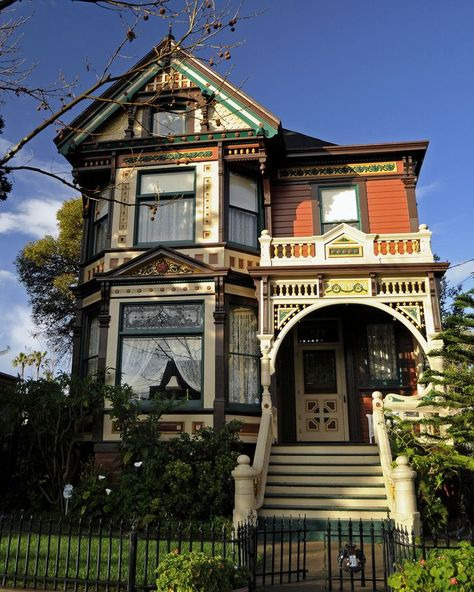

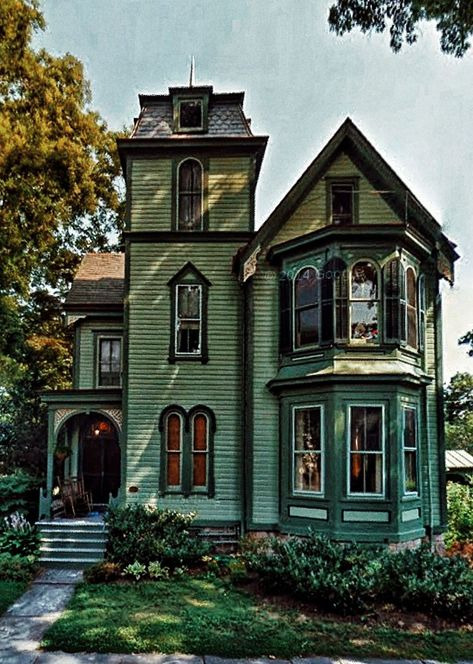
Whimsical victorian houses
12K notes
·
View notes
Text
Theme Project Proposal
Project Title: The Elegance of Victorian Mansions
For my Theme Project, I will capture images of Victorian mansions and their intricate architectural elements. These historic houses, built primarily between 1837 and 1901, possess typical elaborate facades, steeply pitched gables, ornament trim, and bold colors. Victorian architecture blends many inspired eras, such as Gothic, Romanesque, and Queen Anne styles, focusing on craftsmanship and wealth. These homes are generally maintained as heritage sites, presenting a glimpse into an era that was once trending. I want to highlight their historical and cultural significance by photographing their intricate patterns and architecture.
I am drawn to the subject because of my art, design, and interest in historic architecture background. Being an Animation/Intermedia major, I appreciate the art of structural design, and Victorian mansions offer an excellent study of complex detail and storytelling in architecture. The homes represent an era of artistic expression that draws on my affection for aesthetics and visual storytelling.
I will shoot Victorian mansions to create these photos from various angles, looking at key architectural details such as turrets, stained-glass windows, carved woodwork, and grand staircases. I will use natural light to show texture and shadow, experimenting with various times of day for unique moods. I will look to shoot preserved mansions near my area, asking for permission as necessary for closer access. Equipment-wise, I would use a professional camera (if allowed) to shoot full shots and a macro lens for close-up work.
This project aims to unveil the beauty and history of Victorian mansions in my area. Like many houses, it tells a story. I want my audience to notice the art and craftsmanship put into these structures and how architecture tells us about the past. With these images, I want to evoke a sense of nostalgia and admiration at the elaborate designs that mark this era through these images. Last but not least, my hope is for my project to connect the past with the present, helping people see that old buildings are more than just structures—they are works of art and essential parts of history.
0 notes
Text
Chester: The UK's 'Historic Gem' by the Water Named Among World's Best Cities to Visit in 2025

Founded as a Roman fort in 79 AD, Chester boasts a history that spans millennia. The city's most iconic feature, the Chester City Walls, forms the most complete circuit of Roman and medieval defensive walls in Britain, offering a scenic 2-mile walk that provides panoramic views of the city and the river Dee.
Another unique architectural feature is the Chester Rows, a series of two-tiered galleries dating back to the medieval period. These covered walkways house an array of boutique shops, cafés, and galleries, making them a must-visit for any traveller.
Dominating the city skyline is the magnificent Chester Cathedral. This historic building showcases a blend of architectural styles from the Romanesque to the Gothic. Visitors can explore its intricate woodwork, medieval carvings, and serene cloisters. (Tripadvisor)

Chester offers a plethora of attractions that cater to diverse interests:
Chester Zoo: Home to over 20,000 animals, the zoo is renowned for its conservation efforts and immersive habitats. In 2025, new exhibits and interactive experiences are set to delight visitors of all ages. (Tripadvisor)
Chester Christmas Market: During the festive season, the city transforms into a winter wonderland with over 70 wooden chalets offering handcrafted gifts, local delicacies, and festive beverages. The market's charming atmosphere makes it a highlight of the year. (The Times)
Chester Heritage Festival: Held annually in June, this festival celebrates the city's rich history with guided tours, re-enactments, and interactive workshops, providing insights into Chester's storied past.
Exploring Chester's Natural Beauty
The River Dee meanders gracefully through Chester, offering opportunities for leisurely boat rides, riverside walks, and picturesque picnics. The Groves, a popular promenade along the river, is lined with cafés and provides a tranquil setting to relax and enjoy the view. (Visit Cheshire)
For nature enthusiasts, Grosvenor Park is a Victorian-era park featuring beautifully landscaped gardens, a miniature railway, and open-air theatre performances during the summer months. It's an ideal spot for families and those seeking a peaceful retreat within the city.

Chester's culinary scene is vibrant and diverse, offering a range of dining experiences from traditional British pubs to fine dining establishments. The city's historic ambience enhances the dining experience, making each meal memorable.
Accommodation options in Chester cater to various preferences and budgets. The Grosvenor Hotel, for instance, offers luxury in the heart of the city, while charming bed and breakfasts provide a more intimate experience. (The Times)
Seamless Travel with XRide
Planning your journey to Chester has never been more convenient, thanks to XRide's comprehensive transportation services. Whether you're arriving via a major airport or travelling from another UK city, XRide ensures a comfortable and affordable ride to your destination.
For those flying into London, XRide offers services such as cab to Luton Airport, London Luton taxis, and Luton Airport taxi, ensuring a hassle-free transfer to Chester. Travellers from the Midlands can benefit from cheap taxi to Birmingham Airport, while those from the North can utilise cheap taxi Manchester and taxi to Manchester Airport services.
If you're arriving via London Stansted, XRide provides Stansted Airport transfer, taxi to Stansted Airport, Stansted cabs, and Stansted Airport taxi services. Similarly, for those landing at Gatwick, options like Gatwick Airport taxi and cabs Gatwick Airport are readily available.
Travellers heading to Scotland can take advantage of cheap taxis to Edinburgh Airport, taxi Edinburgh Airport, and airport transfer Edinburgh services. XRide also offers cheap cab Heathrow and taxi to Heathrow Airport for those utilising London's busiest airport.
With XRide's extensive network, including airport transfers UK, minicab, cheap taxi, cheap airport taxi, and London taxi service, you can rest assured that your transportation needs are covered. The taxi fare calculator on XRide's website allows you to estimate your travel costs in advance, ensuring transparency and affordability.
Experience Chester with XRide
As you plan your visit to Chester, let XRide be your trusted travel partner. With a commitment to reliability, affordability, and exceptional service, XRide ensures that your journey is as memorable as the destination itself. Book your ride today at x-ride.co.uk and embark on an unforgettable adventure in one of the world's most enchanting cities.
Links:
Travel and Tour World
Tripadvisor - Chester Attractions
The Times - Christmas Markets
Visit Cheshire
The Times - Best Hotels in Cheshire
0 notes
Text


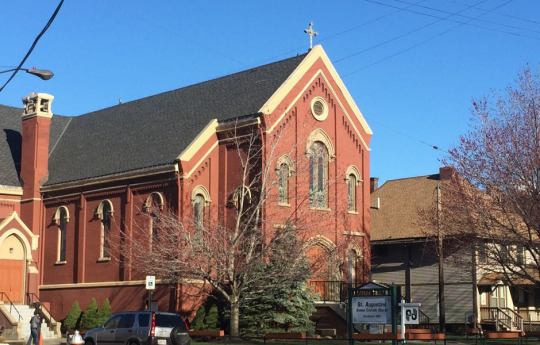

St. Augustine Roman Catholic Church (Old Pilgrim Church)
2486 W 14th St,
Cleveland, OH 44113
St. Augustine Parish in Cleveland, Ohio, has had a long and wonderful history. This is a story of a people of faith that began in 1860 and continues to this day. The parish has always been an "immigrant" community. At the very beginning it welcomed the Irish families that had settled in what is now called the Tremont area of Cleveland. Soon it welcomed people of German background, and then the other immigrant communities as they came to Cleveland. St. Augustine Parish was formed in 1860 as part of Ohio City's St. Patrick's Parish—one of the oldest Catholic parishes in the city. Other Tremont churches formed from St. Patrick's include Annunciation Greek Orthodox Church (1871) and St. John Cantius (1899).
The need for a new parish in Tremont arose as people of Irish descent began moving into the neighborhood. In 1896 the Cleveland Catholic Diocese purchased the old Pilgrim Congregational Church, whose congregation had recently moved into a new building at the corner of West 14th Street (Jennings Avenue) and Starkweather Avenue. The “new” St. Augustine had been built in the 1860s in Victorian Gothic style, replacing the original frame church which stood at Tremont Street and Jefferson Avenue.
St. Augustine is an interesting blend of Romanesque and Gothic styles. Its Romanesque features include a corbel table–that is, a line of stone blocks–below the roofline; large gables; and rectangular columns or pilasters. The pointed arches above several of the entrances are more Gothic in design. Later in its history, it welcomed members of the Hispanic community as they, too, came to Cleveland, and to meet the needs of the neighborhood's changing demographics began offering Spanish-language services in the 1970s. The congregation focuses particularly tightly on aiding the homeless and people with disabilities.
As St. Augustine welcomed all of these diverging communities to our parish, ittried to respond by ministering to them spiritually, educationally, and socially. The parish has become a place in which those most in need are honored and served. The parish was especially blessed to become the home to the Catholic Deaf community in 1964. Next, it welcomed members of the Catholic Blind community, and later still, it welcomed persons with mental illness. Later, it was honored to become the home to minister to all persons with disabilities. Persons with disabilities have helped to develop the parish mission and ministry, and has allowed it, for the last fifty-five years, to be place of special welcome to disabled people and their families.
Finally, efforts to respond to many needs of people and the needs of the larger community led to the establishment of the St. Augustine Center. That Center, through its daily meal programs, its holiday celebrations, its provision of clothing, utility and rental assistance, crisis ministry, and advocacy for persons in need, has made it possible for the parish to minister to those most in need. Located at 2486 West 14th Street, built in the 1860s, and sold to the Catholic Diocese in 1894, the building originally known as the Old Pilgrim Church is now the current home of St. Augustine Roman Catholic Church.
0 notes
Text
8 Garage Door Ideas for Historic Homes
Historic homes are treasures of architectural beauty, each telling a story of the past. When updating or restoring these homes, it’s crucial to maintain their character while incorporating modern conveniences like garage doors. The challenge lies in finding a garage door design that harmonises with the historic architecture while providing the security and functionality required today. Here are eight garage doors Sydney ideas that blend seamlessly with the historic charm of your home, ensuring that any update you make enhances rather than detracts from its timeless appeal.
Carriage-Style Garage Doors
Carriage-style garage doors are a quintessential choice for historic homes, especially those with Colonial, Craftsman, or Victorian architecture. Inspired by the doors of old carriage houses, these doors typically feature a double door design with distinctive hardware like iron hinges and handles. Originally, these doors would swing open manually, but modern versions can be adapted to function with automatic garage door openers, preserving the aesthetic while adding convenience. Available in both wood and steel, carriage-style doors can be customised with various finishes and details like cross-beams or glass inserts, making them a versatile option that can be tailored to fit the specific period look of your home.
Wooden Garage Doors with Traditional Panelling
Wooden garage doors are a timeless addition to any historic home, offering a warmth and authenticity that synthetic materials often lack. Traditional panelling can range from simple, flat panels to more elaborate raised or recessed designs that echo the architectural details found elsewhere on the home. For instance, a Georgian home might benefit from a six-panel design, while a Tudor-style house might look best with a vertical plank style. The natural grain of the wood can be highlighted with stains or finishes that protect the wood while adding to its visual appeal. To maintain the historical integrity, consider working with a craftsman who can replicate period-appropriate patterns or incorporate custom millwork that matches other elements of your home’s exterior.
Arched Garage Doors
Arched garage doors are a nod to the grand architectural styles of the past, particularly suited for homes with Romanesque, Mediterranean, or Gothic influences. The soft curve of an arched door can add a touch of elegance and refinement, complementing arched windows, doorways, or entryways on the home. These doors can be custom-made to match the specific curvature of your garage opening, ensuring a seamless and historically accurate look. For added historical flair, consider incorporating glass panes or decorative ironwork that mirrors the design details found elsewhere on your property. The result is a garage door that feels like a natural extension of the home’s original architecture.
Glass-Panelled Garage Doors
For historic homes with large windows, French doors, or other glass elements, glass-panelled garage doors can be an excellent choice. These doors allow natural light to flood the garage, creating a bright and inviting space while maintaining the visual continuity of the home’s design. Glass-panelled doors can be designed to mimic the look of traditional windows, with divided lites or mullions that match the style of the house. Frosted or textured glass can be used to maintain privacy while still allowing light to enter. Additionally, glass-panelled doors can be framed with wood or metal, depending on the architectural style of the home, offering a modern twist on a classic design.
Reclaimed Wood Garage Doors
Using reclaimed wood for your garage doors is a sustainable and historically respectful choice. Reclaimed wood carries the charm and character of its previous life, often showing weathered textures, rich patinas, and unique imperfections that add to the authenticity of a historic home. This material is especially fitting for rustic or farmhouse-style homes but can be adapted for use with other architectural styles as well. The weathered look of reclaimed wood can enhance the sense of continuity, making it appear as though the doors have been part of the home for centuries. To further enhance the period look, consider pairing reclaimed wood with wrought iron hardware, such as strap hinges, clavos (decorative nails), and pull handles. These elements add to the door’s historical authenticity while providing a durable and functional entrance.
Barn-Style Sliding Garage Doors
Barn-style sliding doors evoke the rustic charm of rural historic homes, particularly those with agricultural or craftsman roots. Unlike traditional garage doors that lift up and over, these doors slide open horizontally on tracks mounted above the door. This sliding mechanism not only serves as a functional alternative, particularly in homes with low garage ceilings or where overhead clearance is limited, but also as a design statement. The visible tracks, often made of iron or steel, can be a focal point, especially when paired with the right decorative hardware. These doors work exceptionally well with homes that have a more informal, country-style aesthetic, but can be adapted for other styles with appropriate finishes and detailing.
Victorian-Inspired Garage Doors
Victorian homes are known for their intricate details, ornate designs, and bold colours, all of which can be reflected in a Victorian-inspired garage door. These doors often feature decorative trim, stained glass windows, and unique hardware that mirrors the architectural style of the home. The key to achieving a cohesive look is customisation. For example, a Queen Anne-style home might benefit from a garage door with elaborate scrollwork, while a more restrained Italianate house could use a simpler, yet still ornate, panel design with bracketed cornices. Stained glass inserts can add a touch of colour and light, while carefully selected paint colours can tie the garage door to the overall colour scheme of the home. Customization is key here to match the elaborate design elements of a Victorian facade, ensuring that the garage door feels like an integral part of the home’s original design.
Painted Steel Garage Doors with Faux Wood Finish
If you desire the look of wood without the maintenance, consider painted steel garage doors with a faux wood finish. Advances in technology have made it possible for steel doors to convincingly mimic the appearance of wood, complete with wood grain textures and natural colour variations. This option provides the durability and low maintenance of steel—resistance to warping, cracking, and rotting—while offering the classic look of wood. This can be particularly appealing in climates where wood doors may require frequent upkeep. Steel doors can also be insulated, making them a practical choice for garages that are attached to the home or used as living spaces. The faux wood finish can be customised to match the specific type of wood found on other parts of the home, ensuring a cohesive and historically sensitive appearance.
Choosing the right garage door for a historic home involves balancing aesthetic authenticity with modern functionality. The garage door should complement the home’s architectural style, enhancing its historic charm while providing the security, durability, and convenience expected in a modern garage. Whether you opt for the rustic appeal of reclaimed wood, the elegant curves of an arched door, or the intricate details of a Victorian-inspired design, the key is to select a style that respects the history of your home while meeting your practical needs. With these eight ideas, you can enhance the beauty of your historic home, preserving its unique charm for years to come, while ensuring that it continues to serve the demands of modern living.
0 notes
Text
Rediscover Charm: Historic Downtown Sedalia, Missouri's Shopping and Dining Delights.
Nestled in the heart of Missouri, Historic Downtown Sedalia offers a delightful blend of history, culture, and modernity. With its rich heritage dating back to the 19th century, this charming district invites visitors to stroll along its tree-lined streets and explore its diverse array of shops and eateries. From boutique shops to savory dining spots, here’s a glimpse into the vibrant shopping and dining experiences awaiting you in Historic Downtown Sedalia, Missouri.
Shop ‘Til You Drop:
Downtown Sedalia boasts an eclectic mix of boutiques, galleries, and specialty stores, each offering unique treasures waiting to be discovered. Antique enthusiasts can lose themselves in the vast collections of vintage finds at shops like The Sedalia Antique Mall, where every corner tells a story of bygone eras. For those seeking one-of-a-kind gifts and home décor items, places like The Eclectic Owl and Painted Tree Marketplace showcase the craftsmanship of local artisans and makers.
Art lovers won’t want to miss a visit to the Sedalia Visual Art Association Gallery, where rotating exhibits spotlight the talents of regional artists. From paintings to sculptures, there’s something to captivate every artistic palate. Meanwhile, bookworms can peruse the shelves of Reader’s World Bookstore, a beloved local institution offering a wide selection of titles for all ages and interests.
Culinary Delights Await:
After a leisurely shopping excursion, satisfy your appetite with a culinary journey through Downtown Sedalia’s diverse dining scene. From cozy cafes to upscale eateries, there’s no shortage of options to tantalize your taste buds. Start your day with a hearty breakfast at Fitters 5th Street Pub, where the aroma of freshly brewed coffee and sizzling bacon fills the air. Their signature omelets and fluffy pancakes are sure to fuel you up for a day of exploration.
For a taste of authentic local flavors, head to Katy Trail Ice House, a laid-back eatery known for its mouthwatering barbecue and ice-cold brews. Situated along the historic Katy Trail, this rustic gem offers a relaxed atmosphere perfect for enjoying a leisurely meal with friends and family. Be sure to try their signature smoked ribs or brisket, paired with a side of classic mac ‘n’ cheese or tangy coleslaw.
Craving something a bit more upscale? Look no further than Ivory Grille, a fine dining establishment housed in a beautifully restored historic building. Featuring an elegant ambiance and an innovative menu highlighting seasonal ingredients, Ivory Grille promises a culinary experience like no other. Indulge in dishes like seared scallops with lemon beurre blanc or tender filet mignon accompanied by truffle mashed potatoes.
Immerse Yourself in History:
Beyond its shopping and dining offerings, Historic Downtown Sedalia invites visitors to step back in time and explore its rich history. Take a leisurely stroll along Ohio Street, where Victorian-era architecture and charming storefronts harken back to a bygone era. Don’t miss landmarks like the Pettis County Courthouse, a stunning example of Romanesque Revival architecture, or the Katy Depot, a historic train station turned museum celebrating Sedalia’s railroad heritage.
For a deeper dive into the city’s past, consider visiting the Bothwell Lodge State Historic Site, just a short drive from downtown. This sprawling estate offers guided tours of the former home of Sedalia businessman John Homer Bothwell, providing insight into life in Missouri during the early 20th century.
Plan Your Visit:
Whether you’re a history buff, a foodie, or a dedicated shopper, Historic Downtown Sedalia offers something for everyone. Plan your visit today and discover the charm and hospitality that have made this district a beloved destination for generations. From quaint boutiques to savory dining spots, the treasures of Sedalia await your exploration.
0 notes
Text
Exploring the Spiritual Heart: A Journey Through Church in Melbourne

Introduction
Melbourne, the vibrant and culturally rich capital of Victoria, Australia, is renowned for its diverse architecture, dynamic art scene, and thriving multicultural community. Among its many attractions, the city is home to a remarkable array of churches, each offering a unique glimpse into Melbourne's spiritual heritage. These churches, ranging from historic cathedrals to modern worship centers, not only serve as places of religious significance but also as architectural marvels and cultural landmarks. In this article, we will embark on a comprehensive exploration of Church in Melbourne delving into their history, architectural styles, community roles, and much more.
St. Patrick's Cathedral: A Gothic Revival Masterpiece
St. Patrick's Cathedral stands as one of Melbourne's most iconic religious structures. Completed in 1939, this stunning example of Gothic Revival architecture features soaring spires, intricate stained glass windows, and a richly decorated interior. As the principal Catholic church of the Archdiocese of Melbourne, St. Patrick's Cathedral is not only a place of worship but also a significant historical and cultural monument.
St. Paul's Cathedral: An Anglican Jewel in the Heart of the City
Located opposite Federation Square, St. Paul's Cathedral is an Anglican church renowned for its striking neo-Gothic architecture. Designed by the English architect William Butterfield, the cathedral's construction began in 1880 and was completed in 1931. Its beautiful interior, adorned with mosaics and wood carvings, makes it a must-visit site for both worshippers and tourists.
Scots' Church: A Testament to Presbyterian Faith
Scots' Church, one of Melbourne's oldest, was established in 1838. This Presbyterian church, located on Collins Street, is a fine example of English Gothic architecture. Its stunning sandstone façade, exquisite stained glass windows, and impressive pipe organ attract visitors from all over the world.St. Mary Star of the Sea, situated in West Melbourne, is a Catholic church known for its grandiose Romanesque Revival style. Completed in 1900, the church boasts a majestic interior featuring high vaulted ceilings, ornate altars, and intricate frescoes. It continues to serve as a vital spiritual hub for the local community.
Holy Trinity Anglican Church: Embracing Diversity in East Melbourne
Holy Trinity Anglican Church, located in East Melbourne, is known for its inclusive approach and diverse congregation. The church's welcoming atmosphere, coupled with its beautiful Victorian Gothic architecture, makes it a significant spiritual and community center.
St. Francis' Church: The Oldest Catholic Church in Victoria
St. Francis' Church, founded in 1841, holds the distinction of being the oldest Catholic church in Victoria. Situated on Lonsdale Street, this historic church is a place of tranquility amidst the bustling city. Its serene interior, featuring beautiful stained glass and a peaceful garden, offers a perfect retreat for reflection and prayer.
Wesley Uniting Church: A Hub of Community Service
Wesley Uniting Church, located on Lonsdale Street, is not only a place of worship but also a center for community service and outreach. Established in 1858, this church is known for its distinctive neo-Gothic architecture and its commitment to social justice and support for the marginalized.
St. Michael's Uniting Church: A Modernist Marvel
St. Michael's Uniting Church, with its unique modernist design, stands out among Melbourne's religious buildings. Designed by architect Sydney Ancher in the 1950s, the church features an innovative open-plan interior that reflects the Uniting Church's progressive approach to worship and community engagement.
Sacred Heart Church: A Franco-Romanesque Beauty
Located in Carlton, Sacred Heart Church is a fine example of Franco-Romanesque architecture. Built in the early 20th century, this Catholic church is renowned for its beautiful stonework, intricate carvings, and vibrant stained glass windows. It remains a focal point for the local Catholic community.
St. John the Evangelist Church: A Hidden Gem in Toorak
St. John the Evangelist Church in Toorak is an Anglican church that combines traditional and modern elements in its design. The church's serene atmosphere, coupled with its beautiful gardens, makes it a peaceful haven for worshippers and visitors alike.
St. Peter's Eastern Hill: A Historic Anglican Parish
St. Peter's Eastern Hill, founded in 1846, is one of Melbourne's oldest Anglican parishes. The church's Gothic Revival architecture, complete with a bell tower and beautiful stained glass windows, reflects its rich history and enduring legacy as a place of worship and community gathering.
Our Lady of Victories Basilica: A Landmark of Camberwell
Our Lady of Victories Basilica in Camberwell is a Catholic church known for its striking Renaissance Revival architecture. Completed in 1918, the basilica's grand dome and majestic interior make it a prominent landmark and a center of spiritual life in the suburb.
Greek Orthodox Archdiocese of Australia: A Hub of Hellenic Culture
The Greek Orthodox Archdiocese of Australia, located in East Melbourne, serves as a vital spiritual and cultural center for Melbourne's Greek community. The church's Byzantine-style architecture, with its stunning mosaics and iconography, offers a rich visual and spiritual experience.
St. Ignatius' Church: A Jesuit Legacy in Richmond
St. Ignatius' Church in Richmond is a Catholic church established by the Jesuit order in 1867. The church's impressive Gothic Revival architecture and its active parish community make it a significant religious and cultural institution in Melbourne.
Church of All Nations: Embracing Multiculturalism in Carlton
The Church of All Nations in Carlton is an Anglican church that celebrates Melbourne's multiculturalism. Known for its inclusive and diverse congregation, the church plays a crucial role in promoting social harmony and cultural exchange in the community.
St. George's Anglican Church: A Community Pillar in Malvern
St. George's Anglican Church in Malvern is renowned for its beautiful Victorian Gothic architecture and its active engagement in community service. Established in 1869, the church continues to be a vibrant center of worship and outreach in the suburb.
Conclusion
Melbourne's churches are more than just places of worship; they are historical landmarks, architectural wonders, and community pillars. Each church, with its unique history, architectural style, and role in the community, contributes to the rich tapestry of Melbourne's cultural and spiritual landscape. From the Gothic spires of St. Patrick's Cathedral to the modernist design of St. Michael's Uniting Church, these sacred spaces invite us to explore and appreciate the diverse expressions of faith and heritage that make Melbourne a truly remarkable city. Whether you are a resident or a visitor, a journey through Melbourne's churches offers a profound and enriching experience, reflecting the city's enduring commitment to faith, community, and cultural diversity.
0 notes
Text


The Moody Mansion Conservatory, Galveston, TX
This conservatory was used to host orchestras for parties in the adjoining ballroom.
📸: @the-darling-house
#architecture#romanesque#victorian era#conservatory#greenhouse#plant life#plants#plant aesthetic#garden#interiors#home interiors#interior design#photography
5 notes
·
View notes
Text
The Amnesiac : ep02
Lighthouse Boulevard, Pacific Grove
I discovered this little coffee shop a few years back when I moved to Pacific Grove. It’s a local non-corporate affair with interior decoration that looks like it was pulled from a home makeover television program. The white shiplap walls are decorated with wrought iron and Chinese made faux farmhouse accoutrements.
Unlike Monterey’s Cannery Row, just one mile away, Pacific Grove is generally unmolested by tourism. The town is bisected by one main boulevard called Lighthouse which is wide enough for four lanes, but only has two. Down the middle, cars are parked diagonally between loamy islands of cypress trees and white striped crosswalks. It’s a boulevard unlike any other in California, with architecture ranging from Romanesque sandstone commercial buildings to folk Victorian beach cottages. A preponderance of white commercial buildings makes the street feel bright and airy, and invites casual strolling and shopping on foot.
Pacific Grove occupies most of the Monterey Peninsula. To the east is the town of Monterey and the Cannery Row made famous by John Steinbeck. Today, Monterey is mostly a tourist trap replete with generally mediocre deep fried seafood, ice cream shops smelling of fresh waffle cones, and touristy t-shirt and trinket shops. There’s an aquarium to entertain the children, and plenty of bars to entertain the adults.
To the south of Pacific Grove is Carmel by the Sea, the paradisiacal artist enclave that once called Clint Eastwood their mayor. Carmel is one of the last places on earth where it is not uncommon to see aging beatniks, with their tidy tweed trousers, black mock tops, silver goatees, and french berets, walking and doing errands. Carmel’s architecture looks like California’s coastal hobbit shire. Ansel Adams made his home there. Edward Weston did too. Between Pacific Grove and Carmel is 17 Mile Drive. A road so scenic that you have to pay to drive on it.
One could mistake Pacific Grove as the redheaded stepchild of Carmel and Monterey, when in fact, the quaint unassuming nature of Pacific Grove is where the town gets its charm. Known most famously for the monarch butterfly sanctuary, Pacific Grove is a wooded microclimate of coastal cypress trees surrounded by Pacific Ocean. The town is criss crossed with perennially damp bike paths that meander between tiny redwood shake sided bungalows. The sidewalks are littered with pine needles and blacktail deer. People know their neighbors, walk to work, and try their damndest to reach half-a-million-miles in their Saab or Volvo station wagons.
#amnesiac#first person narrative#romance novels#pacific grove#lighthouse boulevard#coffee#coffee shop
1 note
·
View note
Text

#chicago#architecture#chicago architecture#houses#homes#two flat#bungalow#queen anne#greystone#foursquare#romanesque#six flat#three flat#second empire#victorian#cottage#tudor style
41 notes
·
View notes
Text
Gothitecture
gothitecture: architecture appreciated by goths. -Urban Dictionary
Gothitecture is like pornography. ��You know it when you see it. The Addams Family mansion, The Munsters’ house, the Psycho house, the Houses of Parliament, and Cologne Cathedral all spring quickly to mind as examples. But it’s also that dark and hyper-modern new cabin in the mountains, or that steampunk tower in that rundown industrial neighborhood, or the ruins of that 500 year old castle on the outskirts of town. Gothic, Victorian, Baroque, Romanesque, Dark Deco, Post-Modern - any and all of these can fall into this delightful architectural sub-genre so beloved by the darkly inclined.
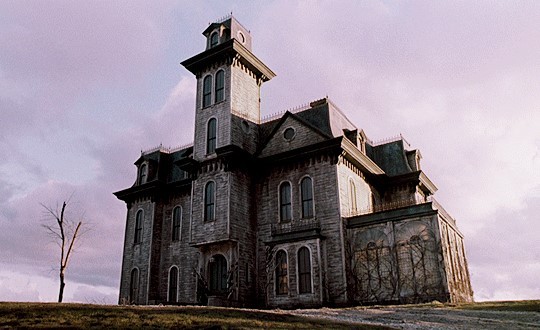
Even as a lad, my eyes would fall upon certain architectural styles and linger upon their lines and sensibilities. They seemed special. They seemed ‘right’. Passing through a neighborhood of cape cods, ranches, and split levels, my eyes would glaze over in disinterest, but as soon as that rare Victorian cottage sprang into view, my mind would jump to life - my eyes drinking up every little detail of the ornate gables, the cast iron fence, the moldings beneath the eaves. These rare beasts seemed to possess a unique quality that made them seem so special. These buildings embodied personality and grace.
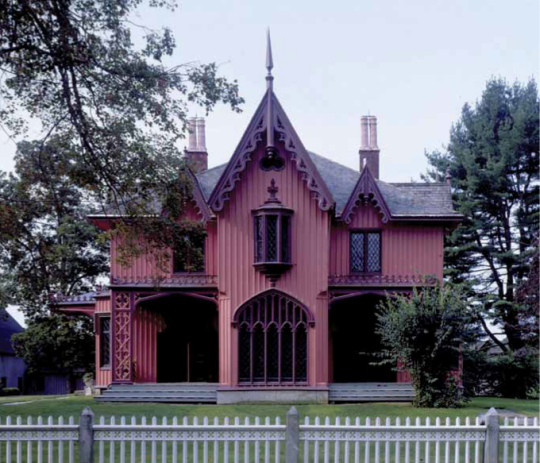
Overly introspective as most goths tend to be, I’ve often wondered as to the origins of this fascination and I may have sussed it out. When I was crazy young, 3 or 4 years of age, my mother was friendly with an old woman who lived in a very modest, yet decidedly Victorian, house. It isn’t quite large enough to be called a mansion, but it’s close. Amazingly, it still stands, although I’m sure the little old lady is long gone. Located in a severely rural area of North Carolina, it lacks the ornate finery of similar homes from even the smallest of towns, but anyone who looks upon it would agree: Victorian.
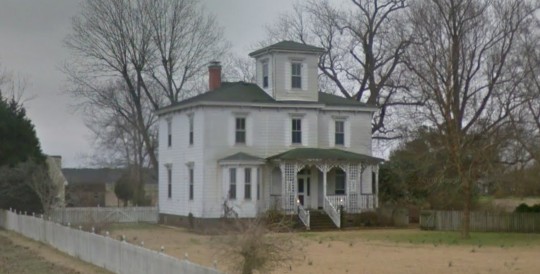
In it’s day, it was likely one of the grander residences of the county, but that day has long passed. To me, it is and always will be special because of the memories that reside within. Visiting the woman who lived there was a special occasion and my mother would make me wear nice clothes and sternly instruct me to be on my best behavior. I was to say, “Yes, ma’am,” or “No, ma’am,” and to otherwise keep my mouth shut. Not the best behaved of children, I was nevertheless happy to comply because of the wonders that hid inside. The house was filled with antique furniture and decor, most of it Victorian vintage. I can still recall being entranced by the a stereoscope viewer complete with image cards from the late 19th century. I remember the intricate crystal candy dish upon the coffee table that held horrid hard candies which might also have been of Victorian vintage. I was obliged to force one down each visit out of politeness, but it was like eating glass. It was worth it because as soon as the women set themselves to the serious business of chit-chat, I was shepherded into a separate room - the room with The Toy Box.
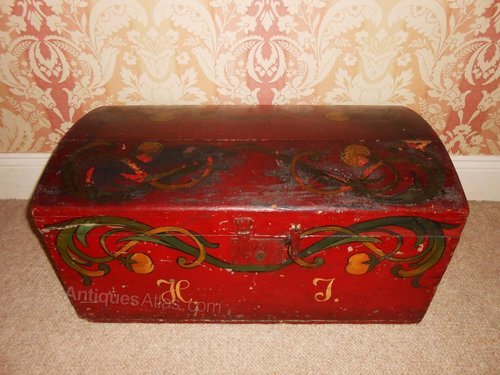
I don’t recall precisely what The Toy Box looked like, but it was large, simple, and painted. Within, were wonders untold. At least 75 years worth of toys lived inside, all in excellent condition and each eager for a child’s attention. My tiny hands fell upon tin soldiers, Jacobs Ladders, hand puppets so old their once heavy cloth was reduced to gossamer wisps, hand carved and painted tigers, horses, elephants, and spring-loaded cannons with accompanying tiny cannon balls. A battered tin Spitfire airplane spoke of the little boy form the war years who ran through the yard holding it high over head so it soared through the clouds. A faded rag-doll recalled the little Edwardian girl who used to hold her close and call her ‘My Dolly’ - it never left that little girl’s side until one day, it did. I’m sorry dolly, I don’t know where your little girl went. Perhaps she’s the old lady in the next room? I seemed to fall into that toy box for weeks at a time, although it was probably less than an hour at a go. Everything seems so much bigger when we’re young, especially time. But not all the toys were happy. There was one that scared me. It was a Jack-in-the-Box.
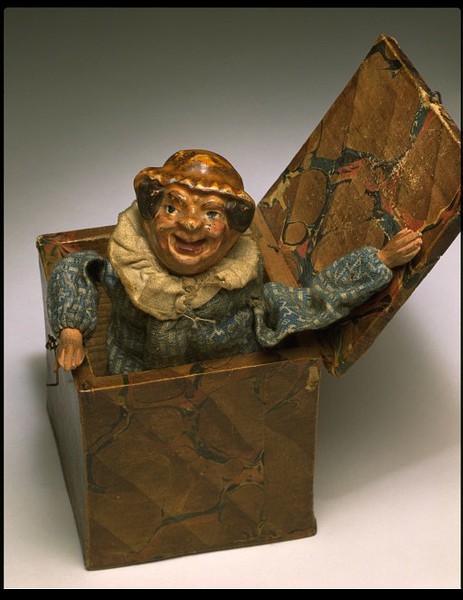
Allow me to clarify: it scared the hell out of me. I don’t know what it was about that thing, but I only ever cycled it once. The music the crank produced was old, sickly, and twisted. The spring rusty and diseased. It didn’t so much pop out as lurch forth. It was a nightmare in a box. I quickly shut it, latched it, and buried it beneath the other toys, but it would continue to make occasional evil sounds whenever I shifted the other toys about. I imagine it’s still there to this day, patiently waiting to terrorize another child. It’s what it does and that’s all it does. But for me, it was an evil contained. I knew it wanted to torment me, but I wouldn’t let it, so I was free to enjoy the wonders of The Toy Box. Such strong memories must carry weight, correct? Is this the reason my eyes linger lovingly on Victorian houses to this day? Perhaps. But what of gothic revival structures, or Romanesque, or Post-Modern? I never spent time inside one of those as a child with a magical toy box. Introspection can sometimes twist into a Shining Maze. Best not to stay too long - you may become frozen inside, forever.
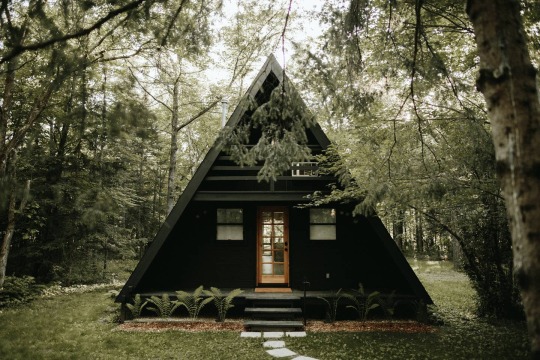
Gothitecture can also spring from a place rather than a form. Take a simple A-frame cabin in a dark wood. We goths do love a good, dark wood. Perhaps a light rain falling from an overcast sky. Ravens caw and circle above. Some forest creature runs by, unseen in the underbrush, but definitely heard - perhaps a wolf? Tendrils of fog drifting across a forest path. As night falls, broken clouds waft past the sickle moon. An owl calls out questions to the shadows beneath the trees. And late into the evening, we gather around a fire pit as the mountain cold wraps about us, and stare into the hypnotic, dancing fire. I’m so there.
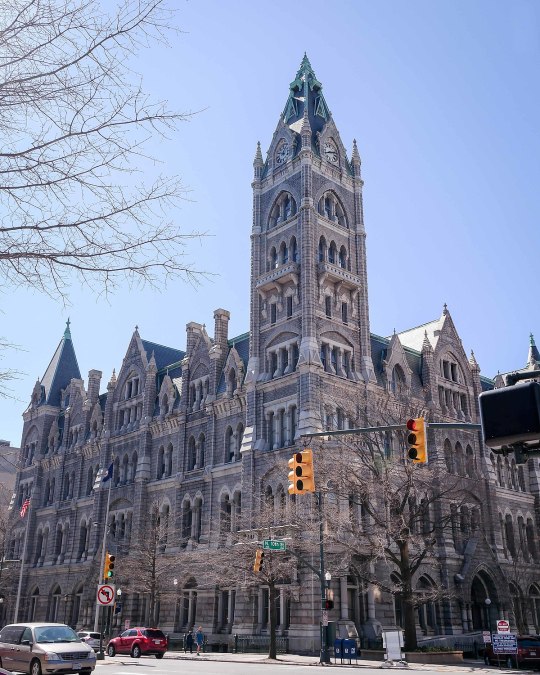
Perhaps we cast our thoughts favorably upon these styles because that’s where we belong and we full well know it. We’re meant to drift about within these halls and upon these grounds. The sounds of our heavy black boots upon stone floors is a thing meant to be. The whisper of long dark coats as they brush across walls is a sound intended. It’s a symbiotic relationship. What’s a Gothic cottage without a goth to reside within? How lonely it must be. Those gargoyles perched upon the gables are not just there to ward off evil spirits, they’re also there to welcome home long lost friends. When you look up at them, give them a friendly smile. They know their kith and kin.
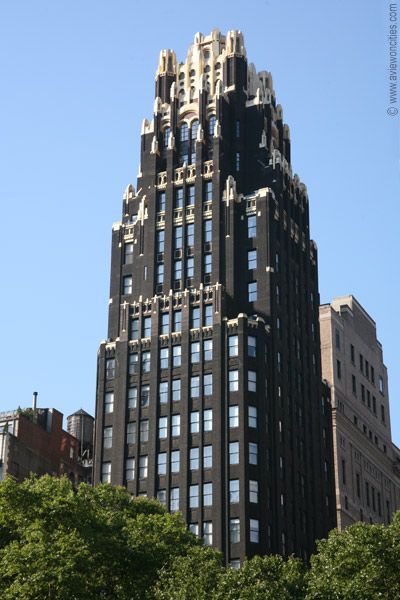
Standing before one of these dark masterworks of space and form, one cannot help but be transfixed, but play the appropriate music to accompany these edifices, and the experience becomes truly profound. Let The Sisters of Mercy, or Switchblade Symphony, or The Damned echo within these halls, and perception becomes sublime. All the pieces fall into place and all is right within our dark world. Goth music was meant to be played within gothitecture while the shadowy forms of goths dance about within. All becomes right with the world.
Perhaps then, even evil toys are lulled into slumber within the forgotten toy boxes of the Counties of Caroline.
creaturesfromelsewhere 12-29-2021
#gothitecture#goth#gothic#dark deco#romanesque#victorian#elder goth#a-frame#post-modern#baroque#musings-from-an-elder-goth#the addams family mansion#the munsters mansion#the psycho house#richmond old city hall#bryant park hotel#the sisters of mercy#switchblade symphony#creaturesfromelsewhere#darkly inclined#spitfire#jack-in-the-box#jacobs ladder#tin soldier#rag-doll#toy box#shining maze#north carolina#the counties of caroline#the damned
22 notes
·
View notes